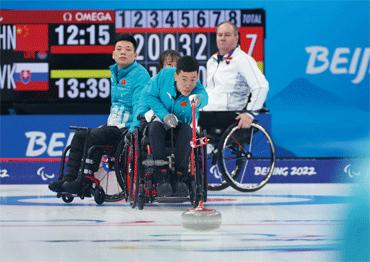The first Paralympics milestone was the Stoke Mandeville Games. Held in 1948 at a hospital for injured war veterans in Buckinghamshire, England, the games included 14 men and 2 women competing in one event – wheelchair archery. German-born neurologist Dr. Ludwig Guttmann (1899-1980) led the project to bring sports to disabled patients, especially those wounded in the World Wars.
The Stoke Mandeville Games evolved into the first Paralympics, which followed the 1960 Summer Games in Rome.
In 1976, the first Paralympic Winter Games was held in Sweden, in part thanks to improved prosthetic designs for skiing by Austrian double-leg amputee Sepp Zwicknagel (1919-1997).
Eight years later, China had its first Paralympian. Ping Yali was born blind and working at rubber factory in Beijing in the early 1980s when recruiters signed her to China’s athletic system. She trained in the long jump, and won gold at the 1984 Paralympic Games in Los Angeles.
The 2022 Beijing Winter Paralympics saw around 600 top-end athletes from across the world competing in 78 events across six sports: Alpine skiing, cross country skiing, biathlon, snowboarding, para ice hockey and wheelchair curling. The 10-day Games drew considerable attention to China’s progress to ensure equal rights for people with disabilities, as well as their well-being and self-development.
“Quality of life for disabled people requires not only substantive support but also equal rights, dignity, equality and security,” Guo Liqun, executive deputy director of the China Commission on Promotion of Publicity for the Undertakings of Chinese Disabled Persons (Commission) said in an interview with the Beijing Evening News.
Among disabled people aged 15 and older, 79 percent are literate thanks to efforts outlined in China’s 13th Five-Year Plan (2016- 2020), according to a blue paper on China’s undertakings for disabled persons released by the Commission, Social Sciences Academy Press and the China Disabilities Institute at the Renmin University of China, on March 1.
However, the paper points out that disabled people in China still face challenges such as relapsing into poverty, less competitive job skills and social inequality – tough issues to be addressed during the 14th Five-Year Plan (2021-2025).
“For people labeled as disabled or poor, sports are one of the rare opportunities to overcome social barriers,” Zhang Yuping, a media and communications lecturer at Guangzhou University specializing in vulnerable groups, sports and media, told NewsChina.
“But we, especially the media, shouldn’t always stereotype disabled people as ambitious and strong-willed. They live, work and pursue their dreams like everyone else, and it’s high time we stop talking about them as ‘others.’”
At the district level, Beijing Disabled Persons’ Federation contracts outside businesses that specialize in elder care, sporting events and community activities, Zhang said. However, many branches are underfunded and are struggling to sustain these services for the long term.
“Without the right funding, these programs will only last for two to three years. This shows social welfare for disabled people in China is not fully developed,” Zhang said.
Zhang also pointed to the large gap in facilities and services for parasports between first-tier cities like Beijing, Shanghai and Guangzhou and China’s smaller cities.
During the 13th Five-Year Plan (2015-2020), coverage of basic rehabilitation services and assistive devices reached 80 percent of the disabled population, more than 85 million people nationwide.
According to the 14th Five-Year Plan (2021-2025), public services for disabled persons still need to be addressed, such as education, healthcare services, rehabilitation and accessible facilities.
The effects of these efforts are far-reaching. On March 12, as he watched his son from the stands win Winter Paralympic gold in their hometown, Chen’s father beamed.
“I am so proud of my son and hope he and his teammates can carry on the Paralympic legacy for more to enjoy,” he said.

 Old Version
Old Version




